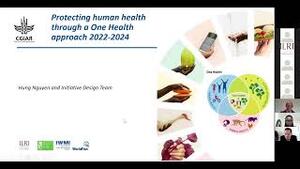
New study finds that urban wildlife may be a significant vector for antimicrobial resistant bacteria
 Researchers entering sampling data (photo credit: Zoonoses and Emerging Diseases).
Researchers entering sampling data (photo credit: Zoonoses and Emerging Diseases).In the cities of developing nations, where unregulated antibiotic use is
common and livestock jostle with people amid often unsanitary conditions,
scientists have found a potentially troubling vector for the dissemination of
antimicrobial resistant bacteria: wildlife.
The epidemiological study published in the June 2019 issue of the journal Lancet Planetary Health shows that urban wildlife in Nairobi carry a high burden of clinically relevant antimicrobial resistant bacteria. The research team included scientists from the International Livestock Research Institute (ILRI), the University of Liverpool and the Kenya Medical Research Institute, among other research institutions.
Antimicrobial resistance is an increasingly serious threat to public
health. Through misuse and overuse of antibacterial medication, more and more
of the bacterial diseases that were once easily treated with antibiotics have
become drug-resistant; these new strains of old germs require expensive and
prolonged treatment at best and at worst can be lethal.
The study deployed teams of veterinary, medical, environmental and
wildlife personnel to sample 99 households randomly chosen from Nairobi’s
socio-economically diverse neighbourhoods.
The study found higher diversity of antimicrobial resistance in
livestock and the environment than humans and wildlife. Rodents and birds were
significantly more likely to carry resistance to multiple drugs when exposed to
human and livestock waste through poor management practices, a common feature
of lower-income neighbourhoods.
“This paper shows that contamination of urban environments with
antimicrobial resistance is a serious issue. This is not just specific to
Nairobi but findings can be extrapolated to other cities in Africa,” said
Eric Fèvre, a joint appointed scientist at ILRI and professor of veterinary
infectious diseases at the University of Liverpool.
“We tend to think of antimicrobial resistance in primarily medical
terms, of developing new drugs and better using old ones. But we need to take
an ecological approach to addressing this threat. Urban cities can address this
by better urban planning, better waste disposal, better livestock husbandry
practices. This can go far toward disrupting antimicrobial resistance exchange
between wildlife, livestock and humans,” said Fèvre.
The lead author of the study, James Hassell, said, “Although we found no evidence to suggest that antimicrobial resistance carried by urban wildlife poses a direct threat to human health, that these animals harbour high levels of resistance to drugs used in human and animal medicine is particularly worrisome. Since wildlife are not treated with antibiotics, this is indicative of how pervasive antimicrobial resistance is in urban environments. Species that move freely across cities and further afield could disseminate resistance acquired in urban areas more widely.”
“We cannot address the rise of antimicrobial resistance without focusing on the environmental, ecological and social settings in which humans exist,” said Hassell.
Citation
Hassell, J.M., Ward, M.J., Muloi, D., Bettridge, J.M., Robinson, T.P., Kariuki, S., Ogendo, A., Kiiru, J., Imboma, T., Kang’ethe, E.K., Öghren, E.M., Williams, N.J., Begon, M., Woolhouse, M.E.J. and Fèvre, E.M. 2019. Clinically relevant antimicrobial resistance at the wildlife–livestock–human interface in Nairobi: An epidemiological study. Lancet Planetary Health 3(6): e259–e269.





















